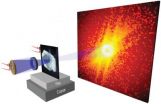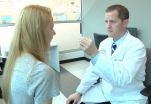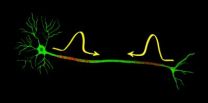(Press-News.org) Objects in space tend to spin — and spin in a way that's totally different from the way they spin on earth. Understanding how objects are spinning, where their centers of mass are, and how their mass is distributed is crucial to any number of actual or potential space missions, from cleaning up debris in the geosynchronous orbit favored by communications satellites to landing a demolition crew on a comet.
In a forthcoming issue of the Journal of Field Robotics, MIT researchers will describe a new algorithm for gauging the rotation of objects in zero gravity using only visual information. And at the International Conference on Intelligent Robots and Systems this month, they will report the results of a set of experiments in which they tested the algorithm aboard the International Space Station.
On all but one measure, their algorithm was very accurate, even when it ran in real time on the microprocessor of a single, volleyball-size experimental satellite. On the remaining measure, which indicates the distribution of the object's mass, the algorithm didn't fare quite as well when running in real time — although its estimate may still be adequate for many purposes. But it was much more accurate when it had slightly longer to run on a more powerful computer.
Space trash
"There are satellites that are basically dead, that are in the 'geostationary graveyard,' a few hundred kilometers from the normal geostationary orbit," says Alvar Saenz-Otero, a principal research scientist in MIT's Department of Aeronautics and Astronautics. "With over 6,000 satellites operating in space right now, people are thinking about recycling. Can we get to that satellite, observe how it's spinning, and learn its dynamic behavior so that we can dock to it?"
Moreover, "there's a lot of space trash these days," Saenz-Otero adds. "There are thousands of pieces of broken satellites in space. If you were to send a supermassive spacecraft up there, yes, you could collect all of those, but it would cost lots of money. But if you send a small spacecraft, and you try to dock to a small, tumbling thing, you also are going to start tumbling. So you need to observe that thing that you know nothing about so you can grab it and control it."
Joining Saenz-Otero on the paper are lead author Brent Tweddle, who was an MIT graduate student in aeronautics and astronautics when the work was done and is now at NASA's Jet Propulsion Laboratory; his fellow grad student Tim Setterfield; AeroAstro Professor David Miller; and John Leonard, a professor of mechanical and ocean engineering.
The researchers tested their algorithm using two small satellites deployed to the space station through MIT's SPHERES project, which envisions that herds of coordinated satellites the size of volleyballs would assist human crews on future space missions. One SPHERES satellite spun in place while another photographed it with a stereo camera.
Cart and horse
One approach to determining the dynamic characteristics of a spinning object, Tweddle explains, would be to first build a visual model of it and then base estimates of its position, orientation, linear and angular velocity, and inertial properties on analysis of the model. But the MIT researchers' algorithm instead begins estimating all of those characteristics at the same time.
"If you're just building a map, it'll optimize things based on just what you see, and put no constraints on how you move," Tweddle explains. "Your trajectory will likely be very jumpy when you finish that optimization. The spin rate's going to jump around, and the angular velocity is not going to be smooth or constant. When you add in the dynamics, that actually constrains the motion to follow a nice, smooth, flowing trajectory."
In order to build up all its estimates simultaneously, the algorithm needs to adopt a probabilistic approach. Its first guess about, say, angular velocity won't be perfectly accurate, but the relationship to the correct measurement can be characterized by a probabilistic distribution. The standard way to model probabilities is as a Gaussian distribution — the bell curve familiar from, for example, the graph of the range of heights in a population.
"Gaussian distributions have a lot of probability in the middle and very little probability out at the tails, and they go from positive infinity to negative infinity," Tweddle says. "That doesn't really map well with estimating something like the mass of an object, because there's a zero probability that the mass of the object is going to be negative." The same is true of inertial properties, Tweddle says, which are mathematically more complicated but are, in some respects, analogously constrained to positive values.
Rational solution
What Tweddle discovered — "through trial and error," he says — is that the natural log of the ratio between moments of inertia around the different rotational axes of the object could, in fact, be modeled by a Gaussian distribution. So that's what the MIT algorithm estimates.
"That's a novel modeling approach that makes this type of framework work a lot better," Tweddle says. "Now that I look at it, I think, 'Why didn't I think of that in the first place?'"
INFORMATION:
The work was funded by both NASA and the U.S. Defense Advanced Projects Research Agency (DARPA).
Written by Larry Hardesty, MIT News Office
Related links
Research update: SPHERES to get powerful magnets and goggles
3-D mapping in real time, without the drift
Where to grab space debris
Algorithm tested aboard the International Space Station analyzes the rotation of objects in space
2014-09-10
ELSE PRESS RELEASES FROM THIS DATE:
Advanced light source sets microscopy record
2014-09-10
A record-setting X-ray microscopy experiment may have ushered in a new era for nanoscale imaging. Working at the U.S. Department of Energy (DOE)'s Lawrence Berkeley National Laboratory (Berkeley Lab), a collaboration of researchers used low energy or "soft" X-rays to image structures only five nanometers in size. This resolution, obtained at Berkeley Lab's Advanced Light Source (ALS), a DOE Office of Science User Facility, is the highest ever achieved with X-ray microscopy.
Using ptychography, a coherent diffractive imaging technique based on high-performance scanning ...
Missing piece found to help solve concussion puzzle
2014-09-10
PITTSBURGH, Sept. 10, 2014 – Researchers at UPMC and the University of Pittsburgh have created a new, 5- to 10-minute test that could be added to a clinician's concussion evaluation toolkit for a more comprehensive assessment of the injury.
In a recent study published online first by the American Journal of Sports Medicine, researchers from the UPMC Sports Medicine Concussion Program demonstrated that clinicians could use their novel Vestibular/Ocular Motor Screening (VOMS) examination to be 90 percent accurate in identifying patients with concussion. The VOMS, which ...
Nerve impulses can collide and continue unaffected
2014-09-10
According to the traditional theory of nerves, two nerve impulses sent from opposite ends of a nerve annihilate when they collide. New research from the Niels Bohr Institute now shows that two colliding nerve impulses simply pass through each other and continue unaffected. This supports the theory that nerves function as sound pulses. The results are published in the scientific journal Physical Review X.
Nerve signals control the communication between the billions of cells in an organism and enable them to work together in neural networks. But how do nerve signals work? ...
Non-dominant hand vital to the evolution of the thumb
2014-09-10
New research from biological anthropologists at the University of Kent has shown that the use of the non-dominant hand was likely to have played a vital role in the evolution of modern human hand morphology.
In the largest experiment ever undertaken into the manipulative pressures experienced by the hand during stone tool production, researchers analysed the manipulative forces and frequency of use experienced by the thumb and fingers on the non-dominant hand during a series of stone tool production sequences that replicated early tool forms.
It is well known that ...
Living liver donors ambivalent with donation
2014-09-10
Living donors are important to increasing the number of viable grafts for liver transplantation. A new study published in Liver Transplantation, a journal of the American Association for the Study of Liver Diseases and the International Liver Transplantation Society, found that ambivalence is common among donor candidates. However, providing social support may help minimize the donors' concerns regarding donation.
There is much demand for organs and a shortage of deceased organ donations. One solution to this shortage is the use of living donors for liver transplantation. ...
How skin falls apart: Pathology of autoimmune skin disease is revealed at the nanoscale
2014-09-10
BUFFALO, N.Y. –University at Buffalo researchers and colleagues studying a rare, blistering disease have discovered new details of how autoantibodies destroy healthy cells in skin. This information provides new insights into autoimmune mechanisms in general and could help develop and screen treatments for patients suffering from all autoimmune diseases, estimated to affect 5-10 percent of the U.S. population.
The research, published in PLoS One on Sept. 8, has the potential to help clinicians identify who may be at risk for developing Pemphigus vulgaris (PV), an autoimmune ...
CNIO successfully completes its fisrt clinical trial on HER-2-negative breast cancer with nintedanib
2014-09-10
The experimental drug nintedanib, combined with standard chemotherapy with paclitaxel, causes a total remission of tumours in 50% of patients suffering from early HER-2- negative breast cancer, the most common type of breast cancer. These are the conclusions of the Phase I Clinical Trial, sponsored by the Spanish National Cancer Research Centre (CNIO) and carried out by CNIO ́s Breast Cancer Clinical Research Unit. The study has been published today in British Journal of Cancer, which belongs to Nature Publishing Group.
According to Miguel Ángel Quintela, ...
Monitoring the response of bone metastases to treatment using MRI and PET
2014-09-10
Imaging technologies are very useful in evaluating a patient's response to cancer treatment, and this can be done quite effectively for most tumors using RECIST, Response Evaluation Criteria in Solid Tumors. However, RECIST works well for tumors located in soft tissue, but not so well for cancers that spread to the bone, such as is the case for prostate and breast cancers. More effort, therefore, is needed to improve our understanding of how to monitor the response of bone metastases to treatment using magnetic resonance imaging (MRI) and positron emission tomography (PET), ...
'Electronic skin' could improve early breast cancer detection
2014-09-10
For detecting cancer, manual breast exams seem low-tech compared to other methods such as MRI. But scientists are now developing an "electronic skin" that "feels" and images small lumps that fingers can miss. Knowing the size and shape of a lump could allow for earlier identification of breast cancer, which could save lives. They describe their device, which they've tested on a breast model made of silicone, in the journal ACS Applied Materials & Interfaces.
Ravi F. Saraf and Chieu Van Nguyen point out that early diagnosis of breast cancer, the most common type of cancer ...
A Mexican plant could lend the perfume industry more green credibility
2014-09-10
The mere whiff of a dreamy perfume can help conjure new feelings or stir a longing for the past. But the creation of these alluring scents, from the high-end to the commonplace, can also incur an environmental toll. That could change as scientists, reporting in the journal ACS Sustainable Chemistry & Engineering, examine a more sustainable way to produce a key perfume ingredient and supply it to fragrance makers around the world.
José M. Ponce-Ortega and colleagues explain that out of the three main ingredients in perfumes, the fixatives, which allow a scent to linger ...
LAST 30 PRESS RELEASES:
Australian team discover why quantum computers have memory problems over time
What determines the fate of a T cell?
Candida auris: genetic process revealed which could be treatment target for deadly fungal disease
Groundbreaking discovery turns household plastic recycling into anti-cancer medication
Blocking a key inflammatory pathway improves liver structure and vascular function in cirrhosis, study finds
Continuous spread: Raccoon roundworm detected in nine European countries
HKUST Engineering researchers developed a novel photodetector to enhance the performance of on-chip light monitoring
Strategic river sensors could have forewarned of Texas Camp flood disaster
Drone sampling of whale breath reveals first evidence of potentially deadly virus in Arctic
Roman soldiers defending Hadrian’s Wall infected by parasites, study finds
Pinochet’s prisoners were tormented with music but still found solace in it, a new book reveals
Fertility remains high in rural Tanzania despite access to family planning
AI-assisted device can improve autism care access
Kinetic careers
Uncovering how parasitic plants avoid attacking themselves to improve crop resistance
Nanoparticle vaccine strategy could protect against Ebola and other deadly filoviruses
Study finds brain care score can predict risk of stroke across racial groups
Key lung immune cells can intensify allergic reactions
Do hormones explain why women experience more gut pain?
New materials conduct ions in solids as easily as in liquids
Breakthrough of the Year: Renewable energy begins to eclipse fossil fuel-based sources
LLM use is reshaping scientific enterprise by increasing output, reducing quality and more
Introducing LightGen, a chip for ultra-fast, ultra-efficient generative AI
Astronomers see fireworks from violent collisions around nearby star
ACC/AHA issue new guideline on managing congenital heart disease in adults
Cosmic crash caught on camera
Is talented youth nurtured the wrong way? New study shows: top performers develop differently than assumed
Ants: An untapped resource in the development of antibiotics?
Archaeologists use AI to create prehistoric video game
Mitochondria migrate toward the cell membrane in response to high glucose levels
[Press-News.org] Where to grab space debrisAlgorithm tested aboard the International Space Station analyzes the rotation of objects in space




